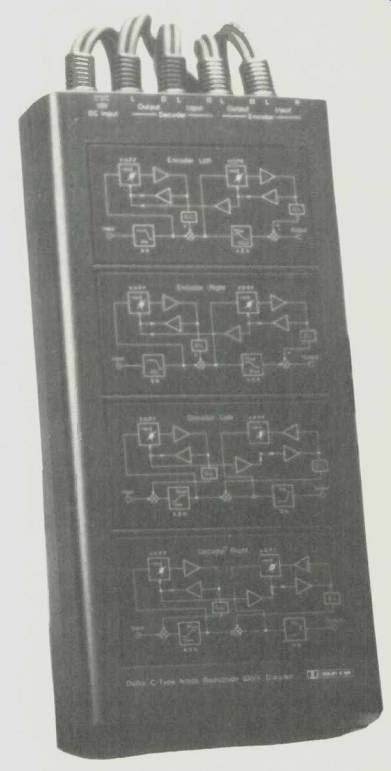
Manufacturer's Specifications
Noise Reduction: Up to 20 dB above 1 kHz.
Input/Output Voltage Levels: 100 mV.
Dimensions: 44 in. (120 mm) W x 1 3/8 in. (41 mm) H x 9-7/16 in. (240 mm) D.
Weight: 1.9 Ib. (0.9 kg).
Price: $230.00.
The Nakamichi NR-100 Dolby C add-on unit is intended for specific use with the Nakamichi 700ZXL or 1000ZXL decks. Both of those units have the eight input/output jacks required for connection, and front panel selection of "Ext NR" will switch the Dolby C encoder into the record path and the decoder into the playback. All tests were run with the 700ZXL deck.
The processor is a simple black box with eight high quality signal cables, complete with excellent strain reliefs and gold-plated connectors for minimum contact noise. The power supply cable plugs into the remote-control socket on the back of the 700ZXL (or 1000ZXL), and that cable has a cable socket that can be used with the remote control. The unit has a small red "On" indicator, and there is a set of block diagrams on the top, showing some details of the circuit. With the top removed, it was immediately evident that the construction was high quality: Excellent soldering, complete parts labeling, the eight Dolby 16-pin DIPs in sockets and the inside set of strain reliefs, anchored in a metal bracket. The instructions provided include a very brief discussion of Dolby C and an interconnection diagram, actually sufficient for this unit which has no adjustments of any kind. There will be some details in this report concerning Dolby C, but the reader who would like to dig further is referred to Joseph Hull's article which appeared in the May 1981 issue of Audio.
Measurements

Table I--Record/playback responses (-3 dB limits).
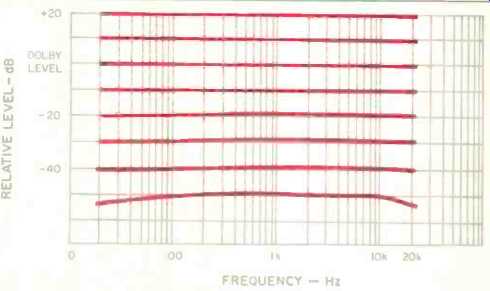
Fig. 1--Encode/decode responses over 70 dB range of input levels.
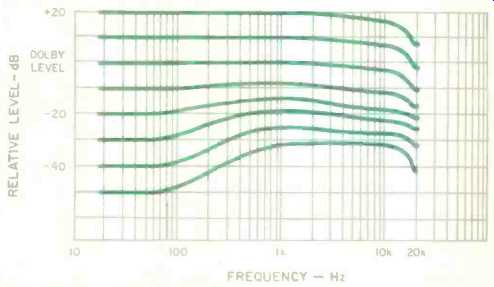
Fig. 2-Encode responses over 70 dB range of input levels.
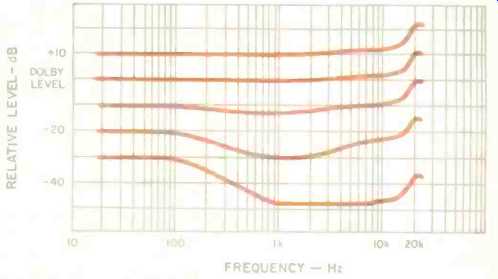
Fig. 3-Decode responses over 4C dB range of input levels.
A basic requirement of any encoding and decoding system is that it be linear for the final output compared to the input. The output of the encoder was connected to the input of the decoder, and a series of swept-frequency responses were made (Fig. 1). The reference voltage level was the 100 mV used for each of the processors, and it is shown as Dolby level on the figure as that is the corresponding record/playback level. The input was varied in 10 dB steps from +20 dB (1.0 V) down to-50 dB (0.32 mV). The tracking was certainly very good with less than 1.5 dB deviation, except for the frequency extremes at-50 dB. Figure 2 is a plotting of the same swept inputs, but with the output just after the encoder. The important characteristics to note are: The gentle downward slope starting just below 2 kHz at-20 dB and above for preventing tape saturation; the sharper roll-off above 10 kHz, referred to as spectral skewing, to prevent expander errors from poor cassette response above 10 kHz; the 19 dB compression re: -50 dB from 1 to 10 kHz, with any effects which extend a bit below the 100-Hz mark.

Table II--Signal/noise ratios with IEC A and CCIR/ARM weightings.
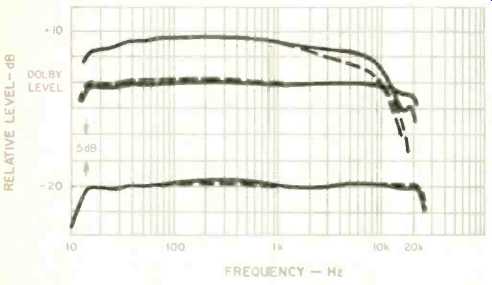
Fig. 4--Record/playback responses with and without (---) Dolby C NR using
Nakamichi SX tape on Nakamichi 700ZXL cassette deck.
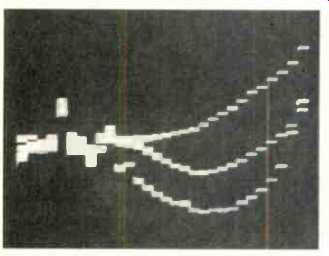
Fig. 5--Output noise spectra with Nakamichi SX tape on Nakamichi 700ZXL deck
with no noise reduction (top), Dolby B NR (middle), and Dolby C NR (bottom).
Vertical scale: 10 dB/div.
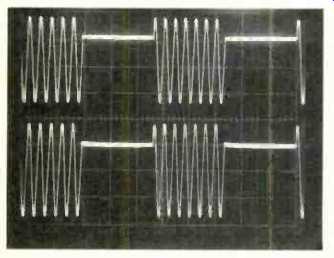
Fig. 6--Five-kHz tone burst from generator (top) and after passing through
both encoder and decoder (bottom). Sweep: 0.5 mS/div.
Swept responses were then taken of the decoder with input levels from +10 to -30 dB re: Dolby level (100 mV). Because of the expansion process in the decoding, it was not possible to cover the same range of input levels. The output levels as shown range from close to -50 dB from 1 to 10 kHz to over +20 dB at 21 kHz. These curves show how the roll-off effects from anti-saturation and spectral skewing are removed in the playback decoding, and how the high noise reduction is accomplished over a good part of the range. A number of record/playback responses were run with the NR-100 and the 700ZXL deck. The results with Nakamichi SX tape are shown in Fig. 4 both with and without Dolby C at Dolby level and at -20 and at +10 dB. The responses are all excellent. Notice particularly the increase in high-frequency headroom both at Dolby level and at +10 dB. This extension is very obvious in Table I, with the -3 dB point shifted from 11.9 kHz to 20.6 kHz by using Dolby C. There were similar benefits obtained with the other tape types.
Figure 5 is a set of three 1/3-octave noise spectra from the 700ZXL deck without any noise reduction (top), with Dolby B NR (middle), and with Dolby C NR. There is no doubt about the great reduction of noise with Dolby B. Also very apparent is the additional reduction that Dolby C secures, below the other curves from about 150 Hz. (Some 60and 180-Hz from the test interconnections caused the apparent discontinuities.) At the 16and 20-kHz bands, the Dolby C noise levels are slightly higher than those for Dolby B, an expected effect from the spectral skewing in Dolby C. A check of the signal-to-noise ratios with the 700ZXL and the NR-100 was made with the three Nakamichi tapes.
Table II shows that with IEC A weighting, Dolby C gained over 15 dB at the 3% points for the three tapes. With CCIR/ ARM weighting, the gain was at least 18 to almost 20 dB with the use of Dolby C NR. These are superlative figures for a cassette deck, and it should be kept in mind that these very low noise results go with a combination (Nakamichi 700ZXL and NR-100) that has outstanding high-frequency headroom.
To check the dynamic response of the encoder/decoder combination, the units were connected directly together as in earlier tests, and a 5-kHz tone burst was fed to the encoder input. The start phase of the burst was purposely offset, but as Fig. 6 shows the final waveform had substantially no distortion.
Use and Listening Tests
Listening tests were run using a number of dbx-encoded discs. It was interesting to find out that Dolby C matched some of these very low noise discs (when decoded). With others, however, the noise with Dolby C was higher than on the original discs. The test did require, however, that the preamp volume be set extra high and that all fluorescent lights in the lab be turned off to eliminate all ballast hum. It would appear that in most listening environments the noise from the tested combination would not be detectable. The NR-100 at $230.00 is a Dolby C unit of excellent performance and a very worthwhile addition to the Nakamichi 700ZXL and 1000ZXL decks.
-Howard A. Roberson
(Audio magazine, Aug. 1982 )
Also see:
Nakamichi Model T-100 Audio Analyzer (Equip. Profile, Nov. 1978)
Nakamichi cassette decks (Dec. 1982)
Realistic Sound Level Meter (Nov. 1978)
= = = =